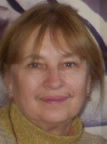|
Plenary Lecture
Late Untargeted Cytogenetic Effects of Human Radiation
Exposure as Possible Markers of Oncopathology

Professor Maria Pilinskaya
Co-author: O. Shemetun
Laboratories of Cytogenetics and Genetic Monitoring
Department of Medical Genetics
Research Centre for Radiation Medicine AMS of Ukraine
Melnikova 53, 04050, Kiev, Ukraine
E-mail: pww@ukr.net
Abstract:
In delayed terms following Chernobyl accident the
important role for realization of late medical
consequences of human radiation exposure (including
oncopathology) take place untargeted cytogenetic effects
- hidden, delayed and transmissible chromosome
instability and "bystander effect".
For investigation of these cytogenetic effects such
models had been modified and applied by us: two-termed
(during 48 and 144 hours) cultivation of peripheral
blood lymphocytes; G2-bleomycin sensitivity assay; mixed
human lymphocytes culture consisted of cells differed by
cytogenetic sex markers. The groups of high priority
with different intensity of radiation exposure due to
Chernobyl accident had been voluntary observed.
In children born to exposed parents increased frequency
of chromatid breaks in long-term cultures confirmed
expression of delayed chromosome instability in
consequent mitosis; appearance of stable aberrations
confirmed transmissible chromosome instability.
In exposed groups investigated by means of G2-bleomycin
sensitivity assay the individual levels of chromosome
aberrations induced by testing concentrations of
bleomycin varied in wide range and didn't depend on
their initial values. Among control donors, liquidators
and Shelter's personnel ~33% persons hypersensitive to
bleomycin exposure had been identified that can be
considered as genetically caused phenomenon. Among
patients recovered from acute radiation sickness ~58%
persons expressed hidden chromosome instability that
assumed modification of inherited susceptibility to
mutagens by high doses of ionizing radiation.
Under joint incubation of targeted lymphocytes received
from Chernobyl liquidators with intact female
lymphocytes the frequency of chromosome aberrations in
bystander cells was significantly higher than their
background level that proved induction of chromosome
instability in untargeted cells as the result of
bystander effect.
The data received confirmed the reality of untargeted
cytogenetic effects in delayed terms following Chernobyl
accident that can be one of risk factor for human
health, especially for induction and promotion of
oncopathology.
Brief Biography of the Speaker:
Maria A. Pilinskaya is Head of Cytogenetic’s laboratory
of Department of medical genetics at Research Centre for
radiation medicine, Ukraine. Her scientific interests
are:
Assessment of mutagenic effects and genetic hazard of
environmental factors for human health; biological
indication and dosimetry of human radiation exposure;
evaluation of nearest and delayed post Chernobyl
cytogenetic effects in human; elaboration of cytogenetic
criteria (especially cytogenetic oncomarkers) for the
selection of risk groups. She is author or co-author
over 350 scientific papers published in native and
foreign reviewed journals or presented at domestic and
international conferences. She is co-author of
Russian-English Dictionary-Reference Book “Radiation
Cytogenetics” (2009). She had the opportunity to work on
probation in the field of FISH-WCP technique at
Livermore National Laboratory, USA. She is a member of
European Cytogenetisists Association.
|
